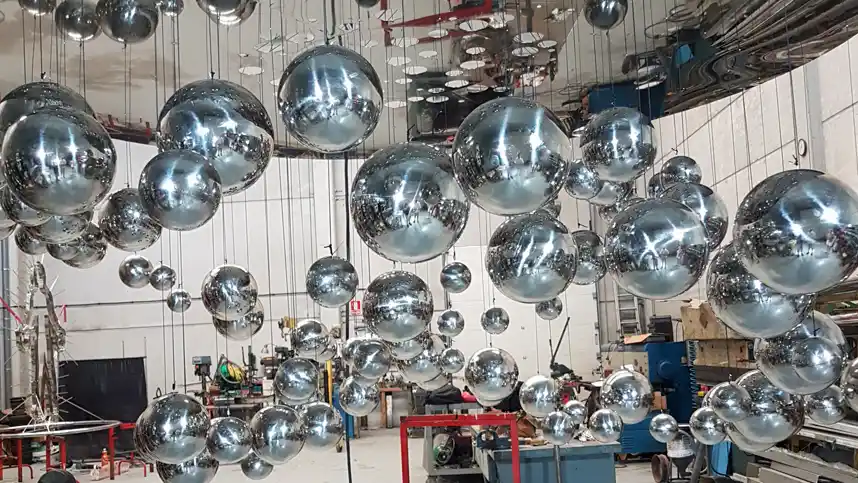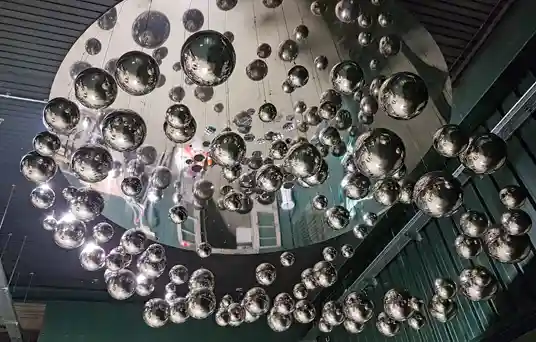Escultura Cinética Metal-Kuiper
Lujo | Hotel | Diseño | Diseño Industrial
Descripción
El proyecto era ambicioso e innovador.
Optaron por construir un local multifuncional, por un lado, tendría que albergar espacios de exposición para material propio, además los mismos espacios se alquilarían para exposiciones y eventos a particulares.
A más a más, se contemplaba también una cafetería y coctelería por las tardes.
Las estancias se decorarían orientadas según la temática que habían elegido, se centrarían en la canica de juegos como eje principal y todo lo que gira alrededor de ella.
Escogieron la canica como icono, por una parte, para representar el concepto del movimiento y todo lo relacionado con este y por otra por una devoción personal que tenían hacia este objeto.
Buscarían obras artísticas y objetos relacionadas con la canica y el movimiento y por ende con la corriente artística del cinetismo o arte cinético.
El arte cinético o arte del movimiento se refiere a una forma de expresión visual en la que la obra da la impresión de estar moviéndose o se mueve en la realidad.
Existen en todo el mundo multitud de obras que representan este movimiento desde finales del siglo XIX hasta la actualidad.
El cliente marco como premisas lo expuesto anteriormente. La pieza tendría que integrarse perfectamente y potenciar la decoración que se estaba planteando, aportando además espectacularidad para conseguir ser un objeto referencial del local.
Concepto
Concepto:
Diseñar y fabricar una escultura cinética, que aporte valor por sí misma y refuerce la personalidad del establecimiento.
Cliente:
1U La avenue
Ubicación:
Vilassar de Mar, Barcelona
Solución
Carlos Portillo, diseñador que forma parte del equipo de Ingeniería y diseño de VisualPlanet - AiConnex, siempre ha sentido atracción por todo lo relacionado con el universo y todos los misterios que de él se desprenden.
En el proceso de conceptualización reparó en el conjunto que forma el cinturón de Kuiper, compuesto por multitud de asteroides que dan lugar a una amplia región con forma de disco y que rodea el sistema solar orbitando a su alrededor.
Este hecho fue determinante durante la búsqueda de la inspiración.
Todos estos elementos sumados determinaron el punto de partida del proyecto.
Se establecieron premisas marcado el diseño general de lo que se quería conseguir y poco a poco todo fue tomando forma, pudiéndose definir las diferentes partes y la manera de conseguirlo, se fue concretando la estructura y los mecanismos integrantes para establecer los movimientos y la estética buscada.
Se fijo que la escultura contendría 99 esferas de diferentes diámetros para hacer un guiño a Albert Einstein, cada una de ellas tendría un movimiento único y en conjunto tendrían que componer una coreografía concreta.
(El elemento 99 en la tabla periódica es el einstenio, un elemento sintético con un significado especial en la ciencia y la historia, nombrado en honor a Albert Einstein).
La ingeniería jugo un papel destacado en la formalización de la pieza escultórica, tanto en el diseño como en el anclaje en la ubicación final.
El movimiento de las partes se realizó mediante sistemas íntegramente mecánicos, los objetivos marcados para los movimientos que se querían conseguir aumentaron el grado de dificultad del diseño exponencialmente, teniéndose que recurrir a diferentes técnicas, como la fabricación de maquetas a escala impresas en 3D, en las que se realizaron ensayos empíricos que definieron la programación mecánica que replicaría los movimientos buscados.
Los cálculos necesarios y una adecuada proyección en 2D y 3D hicieron el resto.
Decidir el material de construcción era relevante a la hora de conseguir el grado de espectacularidad pretendida, por ello se optó finalmente por el acero inoxidable pulido.
Se invirtió mucho tiempo en investigación y experimentación, pero al final del proceso la recompensa fue grande a la vista de los resultados obtenidos.
Detalles

El Cinturón de Kuiper, toda una inspiración.
Al igual que planetas y cometas atrapados en un cinturón, cada componente parece insignificante por sí solo, pero juntos forman una coreografía que recuerda al comportamiento de los bancos de peces.
La obra está diseñada para ofrecer una experiencia visual relajante y envolvente para el espectador, donde el movimiento fluido de las esferas simula un universo en constante cambio.

Desarrollo técnico de la escultura Metal-Kuiper
Para crear el movimiento cinético sincronizado de las 99 esferas, fue necesario un sistema preciso de relojería interna.
Este desarrollo requirió la creación de docenas de planos técnicos en 2D y 3D, junto con la construcción de maquetas impresas en 3D para realizar pruebas empíricas.
Gracias a esta ingeniería avanzada, se logró dar vida al movimiento fluido y armónico de la obra.

Fabricación y montaje de la escultura
El montaje final fue un proceso laborioso que implicó no solo ensamblar cada pieza con exactitud, sino también planificar su transporte seguro hasta el destino.
La escala del proyecto y la necesidad de precisión hicieron de este proceso una verdadera odisea que culminó con éxito en la instalación de la obra.

Montaje y ajuste de precisión
Cada pieza debía ajustarse con la mayor precisión para garantizar su correcto funcionamiento.
En el interior de la obra, se utilizaron cables de Kevlar de alta tecnología que proporcionan la estabilidad y precisión necesarias para que el resultado sea visualmente espectacular.
Estos cables son fundamentales para mantener la exactitud del movimiento conjunto de las esferas, asegurando un rendimiento óptimo.
Proyectos Relacionados





Arte
Hostelería
Ingeniería
Restauración
Tecnología
Diseño
Diseño Industrial
Hotel
Lujo
